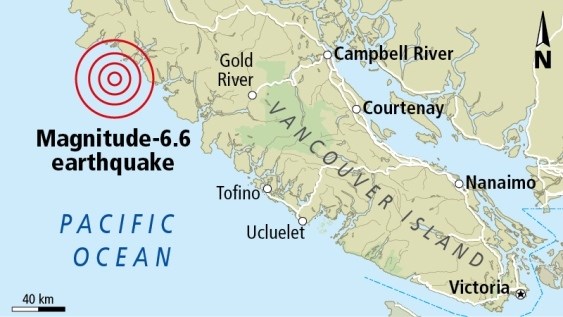The magnitude-6.6 earthquake that struck off the west coast of Vancouver Island on Wednesday night did nothing to release pressure off the Big One, said seismologist John Cassidy.
“It was on a different fault,” said Cassidy, who works with Earthquakes Canada. He said the quake, which occurred about 94 kilometres south of Port Hardy 11 kilometres deep and had several aftershocks, occurred on the Nootka fault line.
“We see these every decade or so. The last one of this magnitude, right in the same area, was in 2004.”
The quake — which the U.S. Geographical Survey initially said measured 6.7 — did not release any energy being stored in the Cascadia subduction zone, from California to the west coast of Vancouver Island, Cassidy said.
EARTHQUAKE PREPAREDNESS: Read our special series — Earthquake 123
“It’s completely locked,” he said. That means pressure for the Big One — a magnitude-9.0 megathrust earthquake — is building. Cassidy said there’s about a 30 per cent chance it could happen in the next 50 years.
Wednesday’s earthquake, which was felt as far away as Prince George and Kelowna, did provide data to help inform developing building codes for seismic activity.
“It generated long-period waves of movement, which is why taller buildings swayed,” he said.
Esquimalt Coun. Dave Hodgins said the earthquake highlighted a lack of preparedness in B.C.
“All of the information was coming from the U.S. or social media,” he said, noting a lack of updates from the provincial and federal governments.
“It was like no one was home,” said Hodgins, who helped establish Emergency Management B.C. in 2006. “It’s become an embarrassment. I’m shocked.”
He said emergency preparedness funding should fall to municipalities so they can ensure the services they need. He also said residents should have at least a week’s supplies in their earthquake kits and take a first-aid course.



